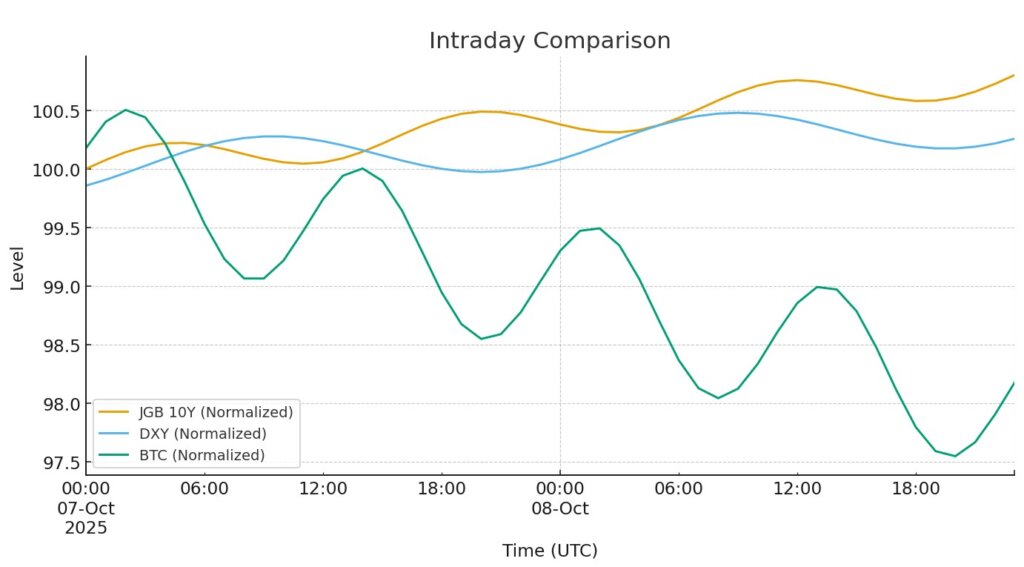Japan's 10-year authorities bond (JGB) yield has reached ranges not seen since 2008, making a situation that places stress on Bitcoin by way of spot depth and order e-book mechanisms quite than direct correlation.
The long-term sale of Japanese authorities bonds has raised home yields, lowering the inducement for Japanese institutional buyers to hunt returns in abroad markets.
Life insurers have already proven a choice for home yen property in current quarters, and the current spike in yields has accelerated that pattern.
International greenback liquidity has shrunk barely as Japanese capital retreats from abroad threat positions, weighing on threat property similar to shares and cryptocurrencies.
How rising authorities bond yields put stress on Bitcoin
Consumers have fled Japanese authorities bonds amid heightened political and monetary dangers, inflicting yields to soar and now redirecting the stream of cash to monetary establishments. The simultaneous depreciation of the yen is including to the stress.
A weaker yen retains the greenback sturdy, and the mixture requires lowering threat throughout carry trades and leverage methods.
Rising hedging prices and widening price differentials make it costlier to take care of leveraged positions, drain liquidity from exchanges, and make Bitcoin worth actions extra mechanical.
This week, the greenback strengthened because the yen weakened, a transfer that thinned the spot market and elevated volatility.
A powerful greenback and tight monetary circumstances have repeatedly coincided with decrease spot liquidity and better short-term volatility. Consequently, greenback power is inversely correlated with Bitcoin and infrequently causes corrections.

This sample is necessary now as a result of the thinner order e-book makes worth actions extra flow-driven and fewer depending on underlying demand.
If the Financial institution of Japan escalates its hawkish rhetoric to forestall the yen from weakening, the rate of interest differential might instantly drive costs up, creating new volatility in threat property.
As Reuters lately reported, a former Financial institution of Japan govt stated the weakening yen might immediate the central financial institution to boost rates of interest in October, a transfer that would slender the unfold with U.S. yields and ease the greenback bid.
ETF demand will proceed in the intervening time
The U.S.-traded Spot Bitcoin ETF recorded internet inflows of $2.1 billion from October 6 to October 7, in line with knowledge from Pharcyde Buyers, displaying stable demand at the same time as macroeconomic circumstances tighten.
On October 7, the fund rebounded to shut at $121,368.23 after withdrawing $875.6 million, at the same time as Bitcoin corrected 2.4% and briefly misplaced the $121,000 degree.
This resilience means that ETF inflows can offset greenback power and liquidity constraints within the brief time period, however whether or not that offset is sustained is dependent upon whether or not inflows keep their current tempo.
Two countervailing forces decide how lengthy ETF demand can soak up macro pressures. First, if the tempo of inflows of billions of {dollars} per week slows, the impression of a stronger greenback and weaker yen on Bitcoin liquidity will grow to be extra pronounced.
Second, if the Financial institution of Japan tightens financial coverage, the hole between Japan and the US rates of interest will slender and the greenback bid will fall, thereby easing stress on threat property and probably restoring some spot depth. Consequently, ETF inflows stay sturdy however are presently delicate to adjustments within the greenback and actual yield atmosphere.
The Oct. 8 influx knowledge will assist make clear how buyers are dealing with the most recent developments in rising authorities bond yields, a weaker yen, and a stronger greenback.


